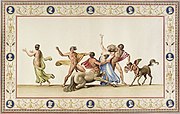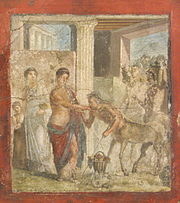
Benna Smuglewicz Rape of Hippodamia
In Greek mythology, Hippodamia (pronounced: /ˌhɪpədəˈmaɪ.ə/; Ancient Greek: Ἱπποδάμεια, from ἵππος hippos "horse" and δαμάζειν damazein "to tame"; also known as Deidamia pronounced: /ˌdaɪdəˈmaɪ.ə/; Ancient Greek: Δηιδάμεια),[1] Laodamia pronounced: /ˌleɪ.ədəˈmaɪ.ə/,[2] Hippoboteia pronounced: /ˌhɪpəbəˈtaɪ.ə/,[3] Dia pronounced: /ˈdaɪ.ə/[4] or Ischomache pronounced: /ɨˈskɒməki/[5]), daughter of Atrax[6] or Butes,[7] was the bride of King Pirithous of the Lapiths. At their wedding, Hippodamia, the other female guests, and the young boys were almost abducted by the Centaurs. Pirithous and his friend, Theseus, led the Lapiths to victory over the Centaurs in a battle known as the Centauromachy.[7][8][9][10] With Pirithous, she mothered Polypoetes,[11] but died shortly after her son's birth.[12]
The abduction of Hippodamia was not an uncommon subject of Western art in the classical tradition, including the sculpture The Abduction of Hippodameia by French artist Albert-Ernest Carrier-Belleuse and a painting by Rubens.

Hippodamia greeted by a seemingly genteel Centaur in a wall painting from Pompeii.
References[]
- ↑ Plutarch, Parallel lives: Theseus, 30. 3
- ↑ In a vase painting: Archäologische Zeitung 29. 159
- ↑ Scholia on Iliad, 1. 263
- ↑ Scholia on Shield of Heracles, 187
- ↑ Propertius, Elegies, 2. 2. 9
- ↑ Ovid, Heroides, 17. 248
- ↑ 7.0 7.1 Diodorus Siculus, Library of History, 4. 70. 3
- ↑ Homer, Odyssey, 11. 630
- ↑ Ovid, Metamorphoses, 12. 224 ff
- ↑ Pausanias, Description of Greece, 5. 10. 8
- ↑ Homer, Iliad, 2. 740
- ↑ Diodorus Siculus, Library of History, 4. 63. 1
Sources[]
- Bulfinch, Thomas (2006). Bulfinch's Mythology the Age of Chivalry. Echo Library. p. 233. ISBN 1-84702-961-2. http://books.google.com/books?id=8CNalMBt9DYC&pg=PA233&dq=Hippodamia+%28wife+of+Pirithous%29&hl=en&ei=wYTRTP3oNIWKlweB48npDA&sa=X&oi=book_result&ct=result&resnum=4&ved=0CDYQ6AEwAw#v=onepage&q=Hippodamia%20%28wife%20of%20Pirithous%29&f=false.
| This page uses content from the English Wikipedia. The original article was at Hippodamia (wife of Pirithous). The list of authors can be seen in the page history. |